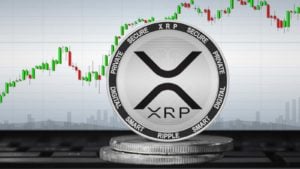Where will cryptos head as the blockchain ecosystem steadily approaches milestone events such as the halving? Naturally, advocates of decentralized digital assets believe that the sector will swing even higher. While that’s certainly a possibility, prospective investors should consider the holistic narrative.
On the bullish front, we’ve heard some amazing forecasts. At this point, a target of $100,000 for the benchmark crypto asset seems a foregone conclusion. Legendary tech investor Cathie Wood is calling for a price of $3.8 million by 2030. I’m not going to complain if that happens. Certainly, the enthusiasm of young investors – who are used to 24/7/365 conveniences – could attempt to make such lofty goals materialize.
However, on the not-so-optimistic side, we’ve already witnessed record outflows away from technology stocks. Not only that, the smart money is diversifying into conservative funds like bonds and even cash. So, we can’t ignore the possibility that hugely profitable investors could exit virtual currencies at scale.
About the only thing that can be said with high confidence is that it’s going to be a wild ride. Below are key cryptos to watch this week.
Bitcoin (BTC-USD)
Source: Sittipong Phokawattana / Shutterstock.com
As the benchmark cryptocurrency, all eyes are on Bitcoin (BTC-USD). That’s especially the case with the upcoming halving event, which should effectively slow the supply of BTC. For supporters, this event represents a clear upside catalyst as it’s arriving during a period of intense interest in cryptos.
At the moment, Bitcoin is charting a consolidation pattern. However, in a broader context, it’s possible that BTC could be in the middle of forming a bullish pennant formation. Specifically, a flagpole appears to have materialized in late February. On the “low” end, we’re possibly witnessing a series of higher lows. And on the “high” end, we’re looking at (again, possibly) a series of lower highs.
When these two lines converge, the pennant formation will reach its apex. At that juncture, Bitcoin’s price action could either break out or break down. Fundamentally, crypto investors are enthused because of the halving event. Still, I’m not a big fan of the fading acquisition volume since late February.
Given some of the clashing signals, I’d watch this space carefully.
Ethereum (ETH-USD)

Source: Thaninee Chuensomchit / Shutterstock.com
As the number two virtual currency by market capitalization, Ethereum (ETH-USD) obviously carries much enthusiasm and support. It also levers much influence on downwind cryptos and that’s where I’m having some issues. Yes, ETH is attractive as a long-term investment. However, some near-term dynamics have sprouted that warrant a closer investigation.
Technically, Ethereum has printed the general shape of a bullish pennant formation. You can see a long slanted flagpole that originated in early February. Starting from late February to late March, there are “invisible” trendlines on the lower and upper price action thresholds. In other words, ETH’s trading dynamics appear to be converging toward a focal point.
However, what’s concerning is that the pattern is volatile and jagged – not unlike a “classic” pennant formation, if you will. Also, it appears that ETH bulls have really struggled to bring the price back above the $3,500 level. And recently, the optimists failed to hold this level. Lastly, I’m not a big fan of the fading volume against a rising price.
As with Bitcoin, Ethereum is one of the cryptos to watch closely before making any big moves.
Tether (USDT-USD)

Source: DIAMOND VISUALS / Shutterstock.com
As a stablecoin, Tether (USDT-USD) lacks the investing directive or ethos of most other cryptos. Stated differently, investors speculate on blockchain assets for their capital gains potential. However, Tether is pegged on a one-to-one basis with the U.S. dollar. Therefore, it’s more of a convenient method of exchange than a typical investment. As well, USDT essentially provides liquidity for the wider blockchain ecosystem.
However, the 1:1 peg to the greenback isn’t perfect. Therefore, it’s possible to extract insights regarding relative value. Over the trailing one-week period, Tether has spent some time below the breakeven point, notably during the March 27 session. That means during much of this session, the dollar was worth more than the peg. Not surprisingly, several cryptos struggled during this cycle.
To be fair, most of the sessions during the past seven days were in the black in favor of Tether. That’s the good news. Still, if you’re going to dive into cryptos, I would monitor USDT first. It can give you some good intel before you make your final decision.
Solana (SOL-USD)

Source: Rcc_Btn / Shutterstock.com
Popular altcoin or alternative cryptocurrency Solana (SOL-USD) briefly regained the number four position regarding market cap before falling back to number five. It’s a tight battle so investors shouldn’t blink. At this juncture, Solana still represents one of the strongest cryptos on record. For one thing, it’s trading above its 50- and 200-day moving averages. It’s also above its 20-day exponential moving average.
As a result of this dynamic, Solana doesn’t quite look like the major cryptos in terms of charting patterns. Rather than the distinctive stop-and-go pattern prevalent in the bullish pennant formation, SOL has basically been marching steadily higher since late February. Obviously, that’s a huge plus for current stakeholders. But it also makes deciphering the forward trajectory difficult.
Will SOL continue to $200 and beyond? It’s possible. However, prospective investors should also note the fading acquisition volume since mid-March. Ideally, you’d want to see a rising price be confirmed by rising volume. A contradictory signal (rising price, fading volume) could imply forward risks.
Be mindful of this circumstance before you make any big moves.
XRP (XRP-USD)

Source: Shutterstock
While ranking among the most popular cryptos, XRP (XRP-USD) also happens to be one of the most frustrating. Significantly, since the summer of 2022, XRP has been printing a series of higher lows. I encourage readers to check out Barchart’s (free) interactive chart of the digital asset. With this tool, you can plot the lower threshold price.
Generally, the trend of rising lows has been strong except for a few notable breaks. Around December 2022 to early January 2023, the trend faltered before picking back up. A similar dynamic occurred early this year. Overall, I’m encouraged that the bulls have managed to restore the trajectory following the technical damage. Nevertheless, you don’t want to incur too much damage.
Frankly, the near-term price action – with XRP falling onto its 50 DMA – presents broader risks. Since this asset lacks the pull of a Bitcoin or Ethereum, there’s not as much confidence that XRP will rise quickly following a volatile incident. Therefore, prospective investors will want to approach with caution.
Cardano (ADA-USD)

Source: Shutterstock
One of the most popular altcoins, Cardano (ADA-USD) struggled for a long time relative to other cryptos following the post-2021 market ecosystem. However, during the so-called “Uptober” seasonality cycle, ADA ranked among the top players. Trading from around 25 cents, it briefly shot up to 80 cents recently before encountering a corrective lull.
At the moment, the narrative isn’t exactly encouraging. Previously, Cardano’s 50 DMA offered tight support. However, in recent sessions, Cardano dipped decisively below this moving average. The good news is that the 200 DMA should provide support. However, the bad news is that the longer-running average sits at 47.7 cents. That’s a long drop from current levels.
Turning to Barchart’s Trader’s Cheat Sheet, ADA benefits from a long line of support levels, ranging from 53 cents to 59.4 cents. However, the declining volume since late February isn’t encouraging. Therefore, you’d like the bulls to show their hands and provide some much-needed support before making big moves here.
Dogecoin (DOGE-USD)

Source: Zarko Prusac / Shutterstock.com
While Dogecoin (DOGE-USD) may have started off as a joke, it has attracted serious money. Currently, its market cap stands at $27.2 billion. It’s ranked as the number eight most valuable crypto, again a notable label for a joke asset. Nevertheless, the current volatility may test even the most dedicated advocate’s commitment.
To be sure, Dogecoin gained about 4% of market value over the trailing seven days since Tuesday early morning. However, in the past 24 hours, it lost almost 9%. With the recent splash of red ink, that puts DOGE near its 20-day exponential moving average. Here, the good news is that Dogecoin trades well above its 50 DMA (14.3 cents) and 200 DMA (9.3 cents).
However, the not-so-great news is that the wild motion is liable to make new investors seasick. Also, Dogecoin has been experiencing fading volume since late February. As mentioned earlier, I’m not the biggest fan of declining volume not confirming a rising price. Therefore, prospective investors should exercise caution.
On the date of publication, Josh Enomoto held a LONG position in BTC, ETH, USDT and XRP. The opinions expressed in this article are those of the writer, subject to the InvestorPlace.com Publishing Guidelines.
This news is republished from another source. You can check the original article here

